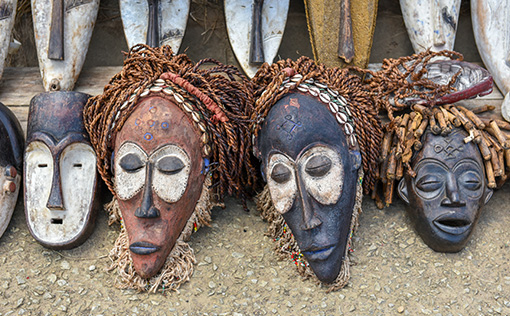
For the exhibition to be a success, all 260 objects first had to be safely collected from their custodians, the traditional rulers of western Cameroon. They were then flown to Paris for the three-month event before being returned home safely. The operation called for a transporter with intimate knowledge of the local terrain and the skills to handle such a delicate undertaking. AGS Cameroon rose to the challenge!
A large-scale project
Celebrating the art of the communities settled on the Bamenda Plateau, the exhibition also featured vast sculptures, metalwork, beadwork, textile creations and traditional dances. Displays showcased the traditions, skills and culture of Cameroon while demonstrating the importance of preserving and sharing heritage as well as its relevance and usefulness today.
Organised in collaboration with the La Route des Chefferies, the sub-Saharan association that works to safeguard and enhance Cameroon’s cultural, natural and creative heritage, nearly 300 works in all were staged along a route designed to offer a view into the heart of Bamileke society.
The artefacts, passed down through generations of traditional rulers, were punctuated by modern Cameroonian artworks to highlight the chiefdoms’ cultural influence on contemporary art and emphasise that their legacy lives on in today’s society.
A journey of obstacles
 The story begins in Bafoussam, a city 15 hours’ drive from Douala, Cameroon’s economic capital. Although the items had previously been collected from each chiefdom and consolidated by La Route des Chefferies, they still had to be inventoried. Together with an expert from the museum, the AGS crew made meticulous notes on each piece’s condition and dimensions to prepare it for packing and transport.
The story begins in Bafoussam, a city 15 hours’ drive from Douala, Cameroon’s economic capital. Although the items had previously been collected from each chiefdom and consolidated by La Route des Chefferies, they still had to be inventoried. Together with an expert from the museum, the AGS crew made meticulous notes on each piece’s condition and dimensions to prepare it for packing and transport.
It would take three weeks on site to build the custom wooden crates required to transport the collection. But the real challenge would prove to be the transport itself. To get the pieces to Douala would take no fewer than six journeys by truck along crumbling roads and under police escort, owing to the tensions in the country.
“Passing through the police checkpoints was extremely complicated,” explains David Lafontaine, Director of AGS Cameroon. “Although we had prepared all the necessary certificates and authorisations, we still had to open the crates in the presence of a lawyer, to prove that the goods inside matched the declaration.”
After drawn out discussions and hours of waiting, the AGS crew was finally able to get underway. It then took six flights between Douala and Lièges, Belgium, to transport the works to Europe. The return journey was easier as they could be placed on a single flight. Although it would take another six trips to get them back to Bafoussam.
A job for specialists
 AGS has been operating in Cameroon since 1995 and has expanded to two offices and 45 employees. Both branches offer physical and digital records management, FF&E installation for the hotel industry, relocation and moving solutions, as well as the specialised services required to move prized works of art and museum artefacts.
AGS has been operating in Cameroon since 1995 and has expanded to two offices and 45 employees. Both branches offer physical and digital records management, FF&E installation for the hotel industry, relocation and moving solutions, as well as the specialised services required to move prized works of art and museum artefacts.
Transporting these precious objects requires a particular set of skills: not only must the packaging be adapted to minimise the effects of moisture and humidity, but the crews must be trained to appreciate the objects in their care and know how to handle them correctly using the proper grips and moves.
Moves involving culturally valuable items also require painstaking preparation. Obtaining the necessary authorisations and documentation, such as CITES certificates, is crucial to prevent delays or additional handling. Clear and timely communication between the various stakeholders is key to avoiding misunderstandings, delays or unforeseen stops in the logistical chain.
Importantly, the preparation phase must take into account the protocols and procedures of the local authorities. In Cameroon, for example, it took three months from the first visit to Bafoussam to deliver the objects to the Quai Branly museum. This was mainly due to the one and a half months needed to obtain the export authorisation from the Ministry of Arts and Culture. Fortunately, the collection could be stored securely in the AGS warehouse during this time.
“The team is proud of the success of this complex project,” adds David. “An assignment of this scale doesn’t come along every day, and it allowed them to demonstrate not only their professionalism but also their ingenuity and responsiveness to ensure that the pieces arrived safely and in time for the exhibition.”
Throughout our global network, AGS crews are trained and experienced in transporting precious antiques and works of art.
If you have a valuable collection that needs to travel, contact us today for your free quote.

